
Correa pulchella, commonly known as the salmon correa, is a species of small prostrate to erect shrub that is endemic to South Australia. It has glabrous, leathery, narrow oblong to broadly egg-shaped leaves and pendulous, cylindrical, pink to red or orange flowers arranged singly on short side branches.
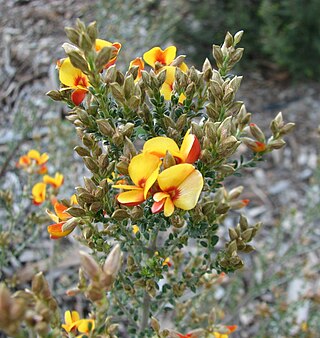
Mirbelia oxylobioides, commonly known as mountain mirbelia or sandstone bushpea, is a species of flowering plant in the family Fabaceae and is endemic to south-eastern Australia. It is a low-lying or erect shrub with narrowly elliptic to egg-shaped leaves and orange-yellow and reddish-purple flowers arranged near the end of the branches.

Mirbelia baueri is a species of flowering plant in the family Fabaceae and is endemic to New South Wales. It is an erect or prostrate shrub with sharply-pointed linear leaves and orange and purple flowers.

Chorizema ilicifolium, commonly known as holly flame pea, is a species of flowering plant in the family Fabaceae and is endemic to the coast of southern Western Australia. It is a slender, erect to spreading shrub with prickly, egg-shaped to lance-shaped leaves and yellowish-orange and red pea flowers.

Hovea chorizemifolia, commonly known as the holly-leaved hovea, is a species of flowering plant in the family Fabaceae and is endemic to the south-west of Western Australia. It is a small, upright shrub with prickly, green leaves and blue-purple pea flowers.
Goodenia sericostachya, commonly known as silky-spiked goodenia, is a species of flowering plant in the family Goodeniaceae and is endemic to a restricted area in the west of Western Australia. It is an erect herb or shrub with silvery hairs, lance-shaped to egg-shaped leaves at the base of the plant and thyrses of blue to pinkish-mauve flowers.
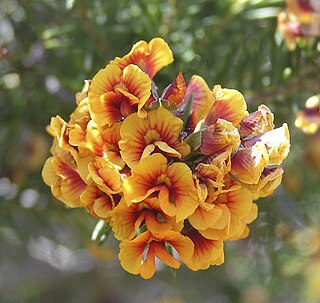
Dillwynia pungens is a species of flowering plant in the family Fabaceae and is endemic to the south coast of Western Australia. It is an erect, spindly shrub with cylindrical leaves and yellow flowers with red or orange markings.
Pultenaea radiata is a species of flowering plant in the family Fabaceae and is endemic to the south-west of Western Australia. It is an erect, open shrub with linear, needle-shaped, grooved leaves, and clusters of red and pinkish-purple flowers.

Pultenaea spinosa, commonly known as grey bush-pea or spiny bush-pea, is a species of flowering plant in the family Fabaceae and is endemic to south-eastern continental Australia. It is a low-lying to erect shrub with glabrous stems, egg-shaped to rhombic leaves, and yellow-orange and red, pea-like flowers.
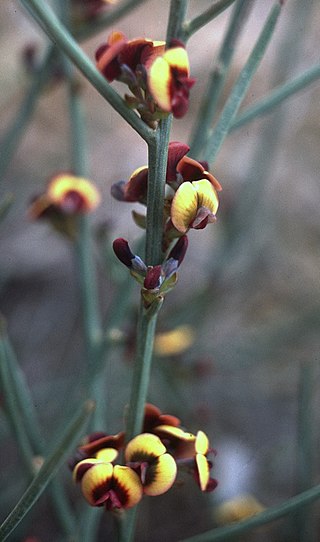
Daviesia debilior is a species of flowering plant in the family Fabaceae and is endemic to the south-west of Western Australia. It is a shrub with low-lying stems and many erect branchlets, scattered linear to scale-like phyllodes, and yellow, purplish, orange-pink and dark purplish flowers.
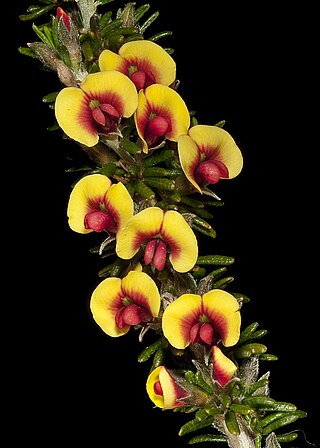
Mirbelia spinosa is a species of flowering plant in the family Fabaceae and is endemic to the south-west of Western Australia. It is a spiny shrub with narrowly linear leaves and yellow, orange and reddish-brown flowers.
Lasiopetalum compactum, is a species of flowering plant in the family Malvaceae and is endemic to the south-west of Western Australia. It is an erect shrub with leathery, narrowly oblong leaves and cymes of white to pinkish flowers.

Daviesia megacalyx is a species of flowering plant in the family Fabaceae and is endemic to a restricted part of the south-west of Western Australia. It is an erect, glabrous shrub with scattered, leathery, elliptic phyllodes and apricot-coloured and deep pink flowers.
Sphaerolobium benetectum is a species of flowering plant in the family Fabaceae and is endemic to the south-west of Western Australia. It is tuft-forming sub-shrub with erect stems, linear to lance-shaped leaves, and yellow-orange and pink to red flowers.

Chorizema carinatum is a species of flowering plant in the family Fabaceae and is endemic to the southwest of Western Australia. It is an erect or spreading shrub with sharply-pointed leaves and bright yellow flowers.
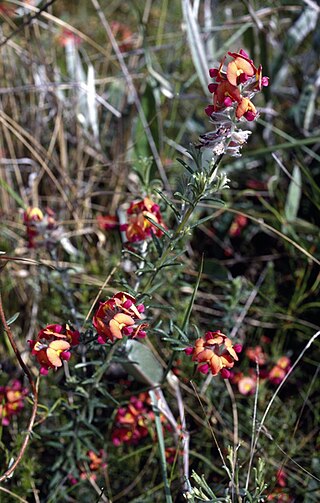
Chorizema cytisoides is a species of flowering plant in the family Fabaceae and is endemic to the southwest of Western Australia. It is an erect to low-lying or sprawling shrub with linear leaves and reddish-orange, yellow and purple flowers.
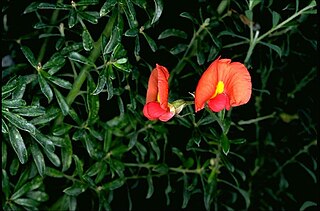
Chorizema dicksonii, commonly known as yellow-eyed flame pea, is a species of flowering plant in the family Fabaceae and is endemic to the southwest of Western Australia. It is an erect or spreading shrub with oblong to lance-shaped leaves and red and orange flowers.
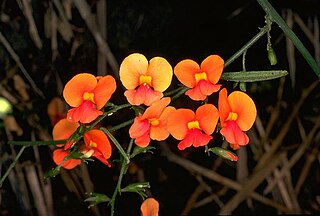
Chorizema diversifolium is a species of flowering plant in the family Fabaceae and is endemic to the southwest of Western Australia. It is a twining or trailing shrub or climber with variably-shaped, egg-shaped to narrowly lance-shaped leaves and pink, orange and red flowers.
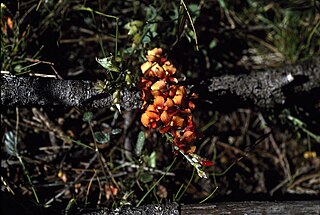
Chorizema humile is a species of flowering plant in the family Fabaceae and is endemic to the southwest of Western Australia. It is a sprawling, prostrate or low-lying shrub with egg-shaped or wedge-shaped leaves and yellow and reddish-brown flowers.
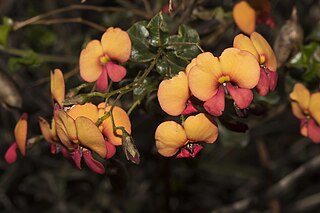
Chorizema nervosum is a species of flowering plant in the family Fabaceae and is endemic to the coast of southern Western Australia. It is an erect or spreading shrub with sharply-pointed, wavy, round to heart-shaped leaves, and yellowish-orange and red pea flowers.
















